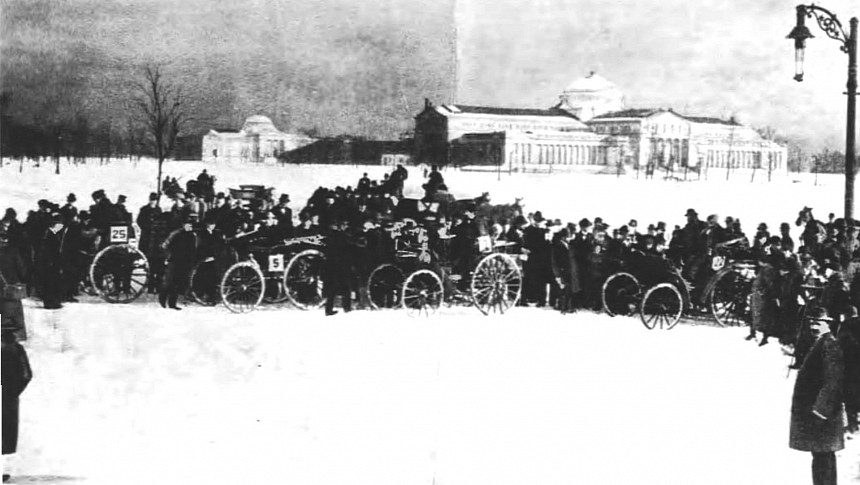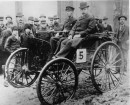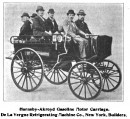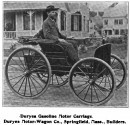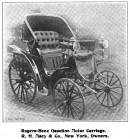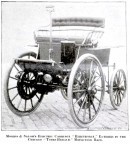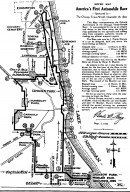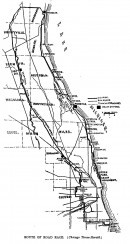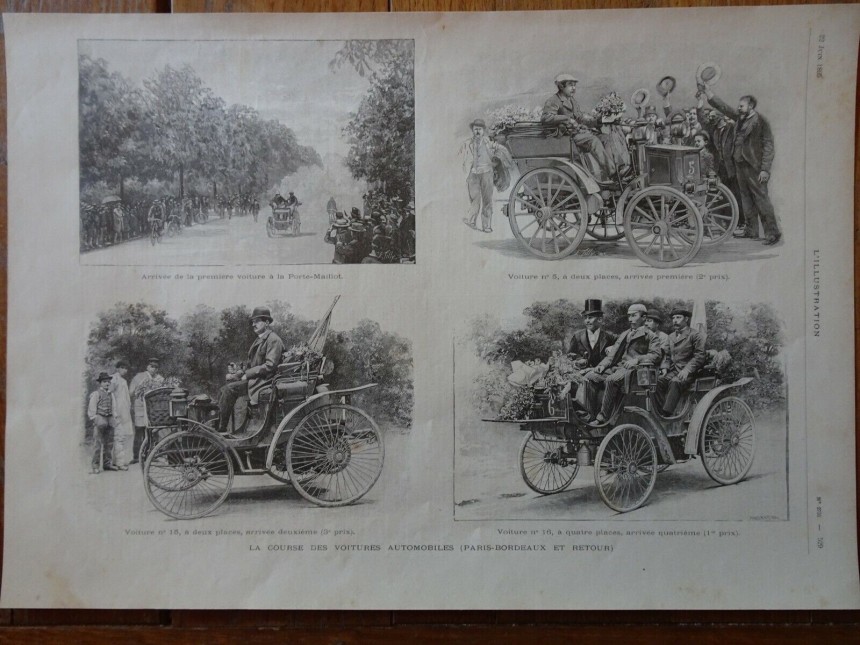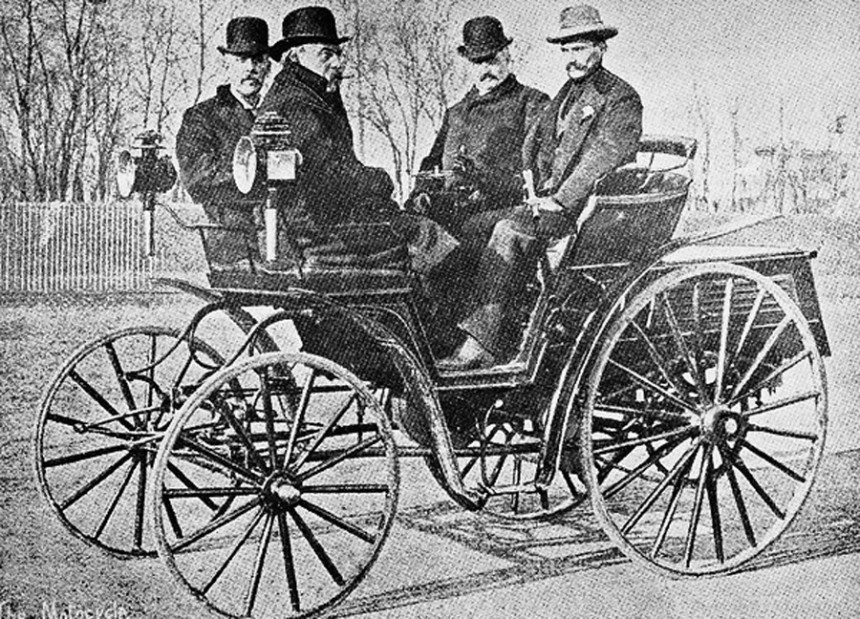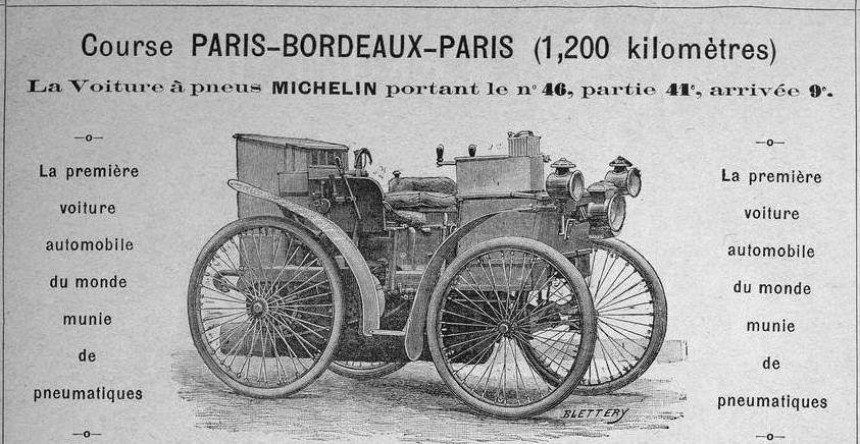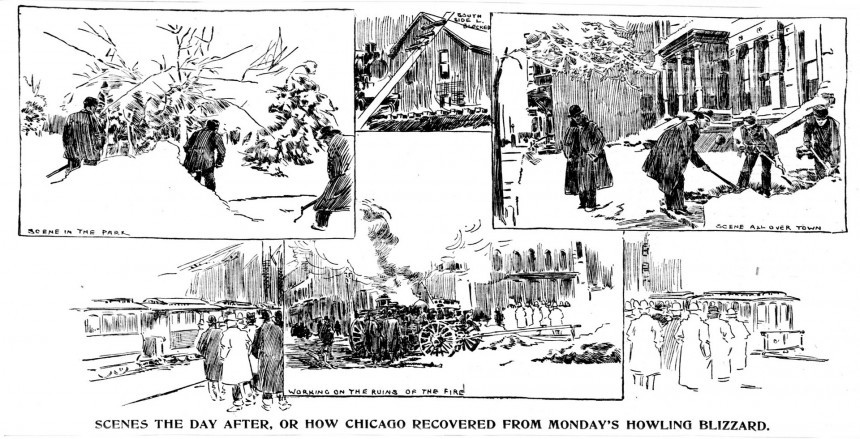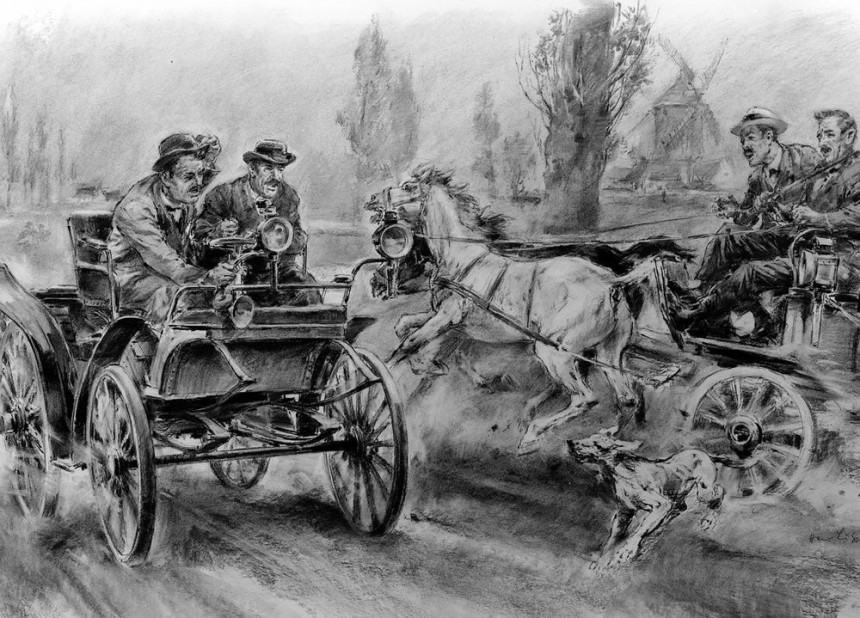NASCAR, Indy, NHRA – choose any of the piston-centered contests held anywhere within the frontiers of the Land of the Free and the Home of the Brave. Each and every single one of those races can be traced back to November 28, 1895. The date marks the official beginning of the motorsports era in the United States of Automobile. Funny enough, it was a race between internal combustion and battery-electric vehicles, even though only six contestants lined up at the start.
Thanksgiving Day, 1895, Chicago, Jackson Park, 08:30 AM. Six odd four-wheeled contraptions and thousands of people await in fervor for the start of a very unusual race. The first ‘motocycles’ (yes, the R is missing on purpose, due to a $500 reason; we’ll explain later) America has seen were going head-to-head for the grand prize of $2,000.
Now, this may seem dismal to us, in a time when a high-end smartphone costs more than that, but the purchasing power equivalent of that sum is $73,255. Not too bad for a contest between something considered eccentric and even downright outrageous at the time. A newspaper editor, Herman Henry Kohlsaat of the Chicago Times Herald, generously sponsored the purse.
Mr. H.H. Kohlsaat came up with the idea half a year earlier when he laid his eyes upon a French publication, L’Illustration, which reported of an automobile race between Paris and Bordeau, of a 732-mile (1,178 km) automobile race between Paris and Bordeaux. True to its name, the French outlet even provided its readers with illustrations from the historic feat (see them in the gallery).
America wouldn’t let the French keep all the progressist glory to themselves for much longer. After all, the European nation had already claimed the wondrous achievement of being the spearhead of humanity’s age-old dream of flying when a chemist and an army officer flew in a hot air balloon in 1783. The Chicago newspaper set up a race for ‘horseless vehicles’ and reserved a budget of $10,000 for the entire event. ‘A Prize for Motors’ was the official title and put a total of $5,000 as the purse for ’inventors who can construct practicable, self-propelling road carriages.’ The other five large were reserved for organizing the never-before-attempted endeavor.
The patriotic pride of America was to be adorned with the laurel of this first-time motoring achievement on July 4, 1895. Around sixty contenders signed up for the glory, fame, and money. However, there was a problem – most of the entries didn’t actually have a vehicle to compete in but rather sketches, drawings, blueprints, dreams, and hopes. Nonetheless, they turned to the publication to finance their builds.
Since the task took a J-Turn for the pocket-burning worse and involved serious investment, the Chicago editor asked for the help of a Democrat politician to keep the inventors’ interest (and the event itself) alive. As it happens, the savior was a certain Grover Cleveland, who, at the time, was otherwise engaged in Washington DC as full-time President of the U.S.A. Since matters of State(s) kept him rather busy, he passed the whole affair into the hands of the War Department.
The Presidential delegation was not without reason since the main argument H.H. Kohlsaat offered when pleading his request for money was centered around the military use of motor wagons. The Army quickly came up with a plan. It even funded the desing and assembly of a testing device for the machines that were to be built under the premises of this technology-demonstrating event. Since nothing like that had ever been tried before, the results of said tests weren’t conclusive for any given purpose. Still, they were intended to measure the fuel consumption and efficiency of the machines.
Despite all conjured efforts, on the National Day deadline, only one contestant was ready (for journalistic accuracy, it was a Haynes-Apperson vehicle of Kokomo, Indiana). Since a contest is based upon the presumption of at least two parties, the race was pushed to Labor Day in September. Come August, the participants called for another postponement. The final date was November 28, Thanksgiving Day.
With that small detail sorted, there was one more problem that everyone had yet to name, literally: the name of the contraptions used in the race. ‘Automobile’ would have been the in-your-face choice since the French had already coined it. But that was the biggest issue with it – it was too Frenchy.
In true American ‘entrepreneur’ spirit (yes, George W. Bush slur intended), the Chicago Times-Herald offered $500 for whoever would come up with the most suitable name. ‘Horseless Carriage,’ ‘Vehicle Motor,’ ‘Automobile,’ ‘Automobile Carriage,’ and ‘Moto Cycle’ were among the propositions. This last version was deemed appropriate, and the event was fully underway.
The race’s original layout was to see the competitors start in Chicago and finish in Milwaukee; bad roads north of Racine imposed a change of plans, and the alternative 52-mile course from Chicago to Evanston and back was chosen. Finally, the big day came, and it brought several unexpected obstacles, all bundled in a blizzard.
Eight-degree Fahrenheit temperatures (negative 13 Celsius) and between six and twenty-four inches (12 to 60 centimeters) of snow made the race all the more interesting – for the final six teams lined up at the start. Most of the more than eighty enlisted contestants couldn’t or wouldn’t show up due to the ill-tempered elements.
At 08:55 AM, the first car shot off the line. Coincidence or not, it was the first entirely- American-made gasoline-powered self-propelled vehicle ever assembled: the Duryea Gasoline Motor Carriage, built by the Duryea Brothers, Frank and Charles, of Springfield, Massachusetts. According to official records, it eventually won the race, leading it for a good portion of the ten hours, twenty-three minutes, and 52.4 miles (84.31 km).
The race wasn’t without incidents, however. At some point along the route, the motor carriage broke down. To put it in the words of the driver, Frank Duryea, ‘While still in the lead, the left front wheel struck a bad rut at such an angle that the steering arm was broken off. This arm had been threaded and screwed firmly to a shoulder, and it was a problem to extract the broken-off threaded part of the arm. Fortunately, when this was finally accomplished, we located a blacksmith shop where we forged down, threaded, and replaced the arm.’
Another issue occurred when one of the motor’s two cylinders ceased fire on the return route from Evanston to Chicago. Fifty-five minutes later, the Duryea was on the road again, and it kept going strong until it crossed the finish line at 07:18 PM. Out of the total 10h23min 'Elapsed Time' (the words of the race marshal - drag racing seeds began rooting in the American motoring consciousness since the inaugural piston-powered race), the winner recorded a running time of 07h53min.
As for the runner-up (and the only other team to make it through the entire course), it had other troubles. One hour before the end, the driver passed out due to exposure to bone-chilling elements, and the vehicle was driven across the line by Charles B. King, the accompanying umpire. The game's rules stated that each vehicle would carry one driver and one judge.
For the sake of motorsports, let us state the performances of these two brave pioneers of all high-speed enterprises that spawned in Chicago 128 years ago to the day. The Duryea averaged 5.05 mph (8,1 kph) and a running average speed of (10.7 kph). The official distance covered during the inaugural motor race was calculated at 52.4 miles (84.3), with a total fuel consumption of 3.5 gallons (13.25 liters) – 14,97 mpg (that’s 15,7 l/100 km).
The other vehicle covered the race in 10h47min, but it took the Mueller machine and its Benz engine 09h32min of actual driving to get from start to finish. The overall speed achieved was 4.87 mph (7.8 kph), while the effective running speed was calculated at 5.51 mph (8.8 kph). The two cars didn’t follow the same course – see the gallery for a map of the distinct route each competitor followed.
As a final curiosity, the race on Thanksgiving Day was initially scheduled for November 2, but only two automobiles arrived on time. In a bizarre twist of fate, the same Duryea-Mueller duel would be repeated on November 28. Since only two participants were present, the big event was postponed. Still, the two teams engaged in a 92-mile (148 km) rally between Chicago and Waukegan, Illinois.
A purse of $500 was at stake, and the Mueller Benz motor wagon claimed it after the Duryea had to abandon it due to a most curious, humorous, and foretelling incident. Frank Duryea drove his namesake vehicle into a ditch to avoid a horse-drawn buggy, hoping to make it over the embankment and go around the bewildered farmer and his frightened horses.
Upon seeing a wagon with no horses approaching from behind, the coachman lost his nerve and composure. He pulled the reins, stirring his team to the left toward the middle of the road, instead of going to the right. The piston-driven machine broke a wheel and forfeited the preamble of the first motor race in America. The horse may have won the first battle but would soon lose the war entirely.
In the end, we should also pay homage to the other four entries that arrived for the start on that cold November day in 1895 in Chicago. Apart from the Duryea and the Mueller, two more gasoline-powered ‘motocycles’ can be seen in a photo of the race (again, see it in the gallery): a De La Vergne Refrigerator Machine Company vehicle (with a Benz motor), and R. H. Macy, again with the same German-patented powerplant. The electric motor carriages were a Morris and Salom from Philadelphia and a Sturges Electric, representing the city of Chicago.
Now, this may seem dismal to us, in a time when a high-end smartphone costs more than that, but the purchasing power equivalent of that sum is $73,255. Not too bad for a contest between something considered eccentric and even downright outrageous at the time. A newspaper editor, Herman Henry Kohlsaat of the Chicago Times Herald, generously sponsored the purse.
Mr. H.H. Kohlsaat came up with the idea half a year earlier when he laid his eyes upon a French publication, L’Illustration, which reported of an automobile race between Paris and Bordeau, of a 732-mile (1,178 km) automobile race between Paris and Bordeaux. True to its name, the French outlet even provided its readers with illustrations from the historic feat (see them in the gallery).
The patriotic pride of America was to be adorned with the laurel of this first-time motoring achievement on July 4, 1895. Around sixty contenders signed up for the glory, fame, and money. However, there was a problem – most of the entries didn’t actually have a vehicle to compete in but rather sketches, drawings, blueprints, dreams, and hopes. Nonetheless, they turned to the publication to finance their builds.
Since the task took a J-Turn for the pocket-burning worse and involved serious investment, the Chicago editor asked for the help of a Democrat politician to keep the inventors’ interest (and the event itself) alive. As it happens, the savior was a certain Grover Cleveland, who, at the time, was otherwise engaged in Washington DC as full-time President of the U.S.A. Since matters of State(s) kept him rather busy, he passed the whole affair into the hands of the War Department.
Despite all conjured efforts, on the National Day deadline, only one contestant was ready (for journalistic accuracy, it was a Haynes-Apperson vehicle of Kokomo, Indiana). Since a contest is based upon the presumption of at least two parties, the race was pushed to Labor Day in September. Come August, the participants called for another postponement. The final date was November 28, Thanksgiving Day.
With that small detail sorted, there was one more problem that everyone had yet to name, literally: the name of the contraptions used in the race. ‘Automobile’ would have been the in-your-face choice since the French had already coined it. But that was the biggest issue with it – it was too Frenchy.
The race’s original layout was to see the competitors start in Chicago and finish in Milwaukee; bad roads north of Racine imposed a change of plans, and the alternative 52-mile course from Chicago to Evanston and back was chosen. Finally, the big day came, and it brought several unexpected obstacles, all bundled in a blizzard.
Eight-degree Fahrenheit temperatures (negative 13 Celsius) and between six and twenty-four inches (12 to 60 centimeters) of snow made the race all the more interesting – for the final six teams lined up at the start. Most of the more than eighty enlisted contestants couldn’t or wouldn’t show up due to the ill-tempered elements.
The race wasn’t without incidents, however. At some point along the route, the motor carriage broke down. To put it in the words of the driver, Frank Duryea, ‘While still in the lead, the left front wheel struck a bad rut at such an angle that the steering arm was broken off. This arm had been threaded and screwed firmly to a shoulder, and it was a problem to extract the broken-off threaded part of the arm. Fortunately, when this was finally accomplished, we located a blacksmith shop where we forged down, threaded, and replaced the arm.’
Another issue occurred when one of the motor’s two cylinders ceased fire on the return route from Evanston to Chicago. Fifty-five minutes later, the Duryea was on the road again, and it kept going strong until it crossed the finish line at 07:18 PM. Out of the total 10h23min 'Elapsed Time' (the words of the race marshal - drag racing seeds began rooting in the American motoring consciousness since the inaugural piston-powered race), the winner recorded a running time of 07h53min.
For the sake of motorsports, let us state the performances of these two brave pioneers of all high-speed enterprises that spawned in Chicago 128 years ago to the day. The Duryea averaged 5.05 mph (8,1 kph) and a running average speed of (10.7 kph). The official distance covered during the inaugural motor race was calculated at 52.4 miles (84.3), with a total fuel consumption of 3.5 gallons (13.25 liters) – 14,97 mpg (that’s 15,7 l/100 km).
The other vehicle covered the race in 10h47min, but it took the Mueller machine and its Benz engine 09h32min of actual driving to get from start to finish. The overall speed achieved was 4.87 mph (7.8 kph), while the effective running speed was calculated at 5.51 mph (8.8 kph). The two cars didn’t follow the same course – see the gallery for a map of the distinct route each competitor followed.
A purse of $500 was at stake, and the Mueller Benz motor wagon claimed it after the Duryea had to abandon it due to a most curious, humorous, and foretelling incident. Frank Duryea drove his namesake vehicle into a ditch to avoid a horse-drawn buggy, hoping to make it over the embankment and go around the bewildered farmer and his frightened horses.
Upon seeing a wagon with no horses approaching from behind, the coachman lost his nerve and composure. He pulled the reins, stirring his team to the left toward the middle of the road, instead of going to the right. The piston-driven machine broke a wheel and forfeited the preamble of the first motor race in America. The horse may have won the first battle but would soon lose the war entirely.
In the end, we should also pay homage to the other four entries that arrived for the start on that cold November day in 1895 in Chicago. Apart from the Duryea and the Mueller, two more gasoline-powered ‘motocycles’ can be seen in a photo of the race (again, see it in the gallery): a De La Vergne Refrigerator Machine Company vehicle (with a Benz motor), and R. H. Macy, again with the same German-patented powerplant. The electric motor carriages were a Morris and Salom from Philadelphia and a Sturges Electric, representing the city of Chicago.
